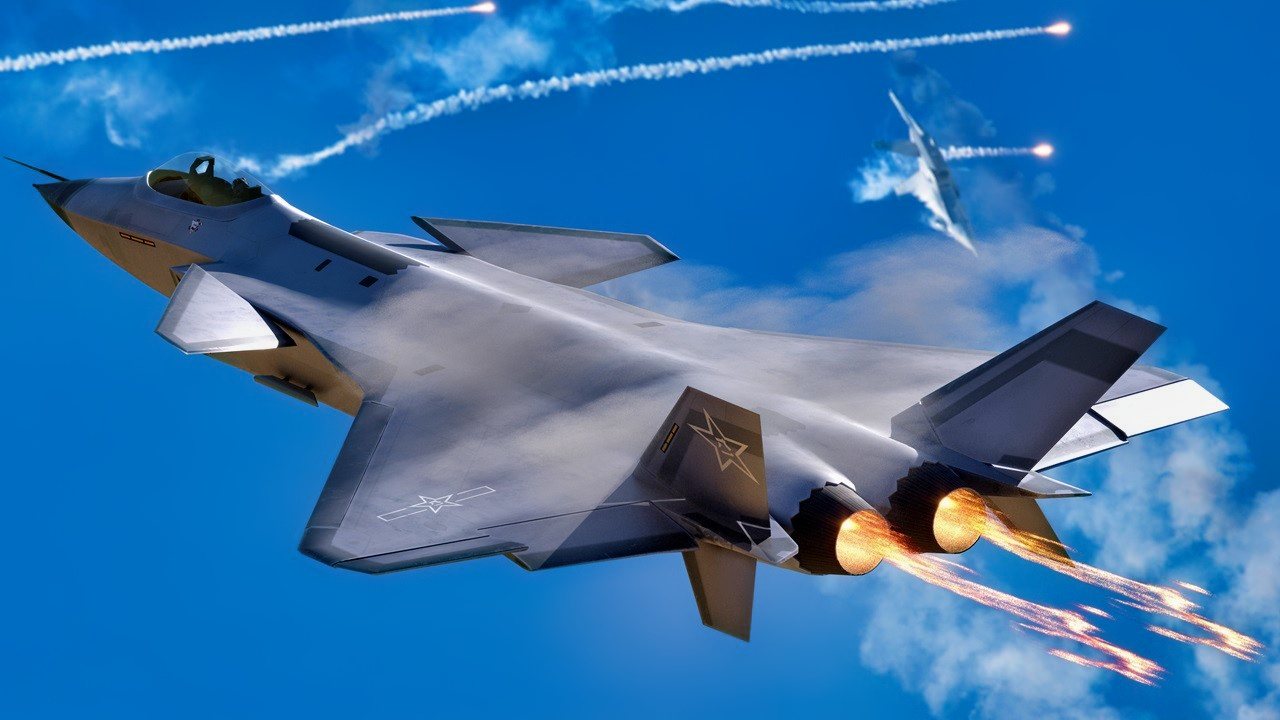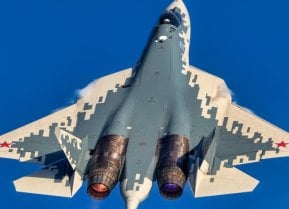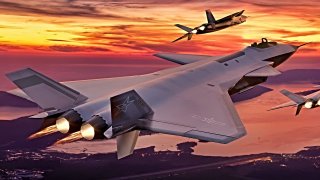Russia and China are Racing to Build the World's Best Stealth Fighter Engine
A stealth fighter is only as good as the engine powering it.
Worse still, these engines were not designed for stealth applications, and as such, render Russia’s stealth fighter far more detectable against both radar and infrared systems thanks to the omission of radar return-mitigating nozzles or active-mixing of outgoing exhaust with ambient air. Put simply, the Su-57 may be a capable fighter, but it isn’t much of a stealth fighter, and its engines are a big part of that problem.
That’s where Russia’s AL-51 finally comes in. Although the Su-57 began flying in 2010, the engine meant to power it didn’t begin formal development until 2015. These new engines are broadly claimed to be on par or even more advanced than American 5th generation engines by Russian media outlets, though to date, there is very little evidence to substantiate these claims. Russia plans to finally start sticking them in airframes later this year.
Russian reports highlight that these new AL-51 engines will be powerful. Russian-friendly media outlets report their non-afterburner power as approximately 24,300 pounds of thrust, just shy of the Raptor’s, but their afterburning power at a jaw-dropping 37,500 pounds. Since the program began, Russian media has claimed significant improvements in maintainability and fuel efficiency as well, which seems in keeping with the developmental stage of the effort, though interestingly, there has been very little official discussion of any stealth improvements fielded in the new engine design beyond incorporating new 2D thrust vectoring nozzles in place of the existing 3D nozzles.
Of course, all of these claims have to be taken with a grain of salt, as independent media doesn’t exist within Russia and the country has a well-documented history of exaggerated military technology. Yet, it does seem likely that these AL-51 engines will help the Su-57 step even further ahead of the 4th generation, even if it remains lagging behind its 5th-generation counterparts.
CHINA’S WS-15
Similar to Russia’s Su-57, China’s growing fleet of stealth fighters has, to date, been powered solely by updated 4th-generation engines that limit stealth and performance. The first J-20s were all powered by Russian-sourced AL-31FM2 engines, until 2015 when China began transitioning toward its own equivalent, dubbed the WS-10. It wasn’t until 2022, however, that China’s long-troubled WS-15 engines meant for these fighters finally made it into flight trials.

Unlike Russia’s stealth fighter fleet, which amounts to little more than parade fodder, China’s growing fleet of Chengdu J-20 stealth fighters now outnumber American F-22s and are understood to outperform the Russian fighter in terms of stealth of overall avionics, despite falling short of the technological bar set by the F-35 and F-22. Also unlike the Su-57, the addition of more advanced and capable engines in China’s J-20s represents more than just headline fodder… and could offer a legitimate increase in strategic capability.
Details about the WS-15 development are murky thanks to an utter lack of transparency in Chinese state-controlled media, but it is believed to have started back in the 1990s. Various media reports over the years have indicated that these new engines will produce 36,000 pounds of thrust, or maybe even 40,000 pounds, under afterburner, making the J-20 the most powerful stealth fighter on the planet. Media reporting also suggests improved fuel efficiency and supercruising capabilities to boot.
But more important than an increase in power output are the undisclosed details about improved stealth. Assuming that China has invested in not just engine performance, but radar and infrared detection mitigation, one could expect these new engines to make the most potent adversary stealth fighter on the planet even more capable. And while it can’t be said for certain that these new engines can match Pratt & Whitney’s F119 and F135 in terms of low-observability and performance, if Chinese claims are to be believed, the WS-15 may well be a legitimate peer to the F119.
But Uncle Sam isn’t taking this one lying down…
ANOTHER TURBOFAN REVOLUTION: ADAPTIVE CYCLE ENGINES
Back in 2016, the Air Force Life Cycle Management Center’s Propulsion Directorate quietly awarded new developmental contracts to GE and Pratt & Whitney to field the next generation of turbofan engines, with the intent of using them to power the next generation of stealth fighters.
Historically speaking, every turbofan design represents a variety of compromises — including the need to balance high-end power output against long-range efficiency. As such, the turbofans designed for cargo aircraft, spy planes, and the like tend to prioritize fuel economy over power generation, while fighter engines prioritize high-end performance over range. Adaptive Cycle engines like those under development within the AETP program, however, aim to throw that compromise away.
“The goal for the Air Force was to develop the next-generation fighter engine architecture and technologies to provide a generational step-change in combat propulsion capability,” David Tweedie, GE Edison Works’ General Manager of Advanced Combat Engines, told Sandboxx News.
This effort, dubbed the Adaptive Engine Transition Program (AETP), sought a modest 10% increase in thrust over the F135 powering today’s F-35, but alongside a 25% increase in range and a substantial increase in thermal management.
To accomplish that, these new engines are designed to operate in different functional “modes.” When the pilot needs the engine’s peak performance in combat, they can lean hard on the throttle and the engine’s management system will take its cue to switch into heavy-burning high-thrust mode for max power. Conversely, while on a patrol, the engine will stay in its high-efficiency, low-burning mode to stretch the mileage or loiter time provided by each gallon of fuel.

In May 2021, GE’s XA100 adaptive cycle engine roared to life, immediately eclipsing the Air Force’s targets. According to Tweedie, they saw greater than a 10% increase in thrust throughout nearly the entire flight envelope, with as much as a 20% increase in some areas. But thrust isn’t the only area where the XA100 excels. Through operating in different propulsion modes, the engine also offered a huge boost in economy.
“When you translate that to what it means to the platform, it’s 30% more range or 50% more loiter time depending on how you want to utilize that fuel burn improvement. It’s a significant increase in acceleration and combat capability with the increased thrust.”
Five months later, Pratt & Whitney’s XA101 followed suit, calling their effort a success, but being less forthcoming with final figures.
But as promising as the increased power and range may be, GE’s claim of twice the thermal management of previous engines may ultimately prove more important.
Heat is currently a limiting factor in fighter power production. Engines like the F135 could produce more power than we permit, because the heat created in the process is so significant that it runs the risk of damaging the fighter’s fragile radar-absorbent skin, or even the fuselage itself. By offering twice the heat management, these new adaptive cycle engines could theoretically also produce twice the electrical power — paving the way for directed-energy laser weapons and missile countermeasures, advanced new electronic warfare systems, and much more.
For a time, the Pentagon even assessed adding these advanced new engines to the F-35 as a part of its Block 4 upgrade, which would have been a boon for the US Navy, which is working tirelessly to find ways to extend the ranges of its carrier-based fighters. Ultimately, the DoD opted for the less-expensive route of simply upgrading the existing F135.
In August of last year, John R. Sneden, propulsion director for the Air Force Life Cycle Management Center, explained that neither the XA100 nor the XA101 would be chosen to power America’s 6th generation fighters — instead, the same technology would be incorporated into even newer engines of… a different size.
Sneden would not clarify if a different size meant larger (as engine designs have progressed in recent decades), but many within the aviation community believe that to be the case. Larger engines may well result in greater power output and the ability to carry larger payloads — both elements of emphasis in America’s 6th generation fighter programs.

These even newer engines, Sneden said, will boast advanced composite and ceramic matrix materials to reduce weight and further bolster their heat management capabilities — and they’re expected to be fielded in time to power the Next Generation Air Dominance Fighter as it cruises toward service at the end of this decade.
So, while China and Russia may finally be closing the gap on one of America’s most important (though little-discussed) stealth fighter advantages in 2024, the United States now seems positioned to restake its claim as the undisputed leader in fighter engine technology in the not-too-distant future.
About the Author
Alex Hollings is a writer, dad, and Marine veteran.
This article was first published by Sandboxx News.


